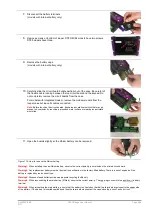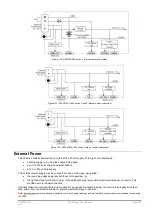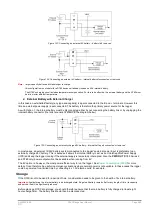
UM-0085-B09
DT80 Range User Manual
Page 298
RG
At 0°C, the overall battery capacity will be reduced by about 20% (compared to 20°C), so the battery life for high and mid
discharge rates will be shortened. However, the self-discharge rate will also be reduced, so for very low discharge rates
the battery life will be comparable to that for 20°C.
Example 1
A DT85 is set up to measure 10 analog channels every 5 seconds. How long can it run using the internal 4.0Ah battery?
The first step is to calculate the average power consumption. Using
, we estimate the core hardware power
consumption at 300mW for a 5 second schedule with 10 analog channels. No other hardware modules (e.g. Ethernet)
are used, so we take this value as the overall power consumption.
Using
, we see that at 300 mW the battery life should be around 3-4 days.
Example 2
A DT80 is powered by the supplied 15V plug pack and every 10 seconds it reads 2 analog channels and polls a serial
sensor (which we assume has its own battery backed power supply). Communications with the host computer use the
Ethernet interface. For how long will the logger be able to run in the event of a mains power failure?
The Ethernet interface is enabled, so the
DT80
will normally not sleep, as going to sleep will cause any network
connections to be disconnected. We therefore cannot use
to estimate average power consumption, because
this table assumes that the logger will sleep between scans.
Instead, we will assume that the
DT80
spends:
•
1 second doing the communications and measurements, logging the result etc. (active power state, analog
subsystem enabled, Ethernet enabled)
•
9 seconds waiting for the next scan to come around (idle power state, analog subsystem disabled, Ethernet
enabled)
, the average core hardware power consumption when battery powered will be 1200mW while active and
300mW while idle. Using Table 15, the analog subsystem will add 650mW while enabled, and Ethernet adds 300mW.
Putting this all together:
Ave Power = (1200+650+300)mW x 1/10 + (300+300)mW x 9/10 = 755 mW
we see that the DT80's 1.2Ah battery should keep the logger running for about 8 hours.
Minimising Power Consumption
In order to minimise power consumption, the general aims are to:
•
disable hardware modules which are not required, and
•
maximise the time spent in the "sleep" power state (see
)
Disable Unnecessary Hardware
Analog Measurement System
Setting
P21=0
(which is the default) will minimise power consumption. When an analog measurement is due, the
analog subsystem will be switched on, then the
DT80
will wait 50 ms for it to stabilise and then take the measurement.
The analog power will remain on until there are no more schedules to execute; hence any subsequent analog
measurements in the schedule or any other schedule due to be executed at the same time will not include this 50ms
delay.
For high speed sampling, where power consumption is less of a concern, it is preferable to set
P21=1
. In this case the
analog subsystem remains powered all the time (except in sleep mode), which removes the need for the 50ms delays.
For situations where the logger stays awake all the time, this setting will also minimise differences between readings due
to the analog section's warm-up characteristic, which can take a few minutes to fully stabilise (see
).
CEM20
Setting
P28=0
(which is the default) will cause the CEM20 power (i.e. the
DT80
12V
output) to be managed in a similar
way to the analog subsystem power when
P21=0
. That is, the power output will be switched on only during schedules
which include a CEM20 analog measurement.
Ethernet Port
The Ethernet interface is enabled by default, and will consume power even if no Ethernet cable is connected. If Ethernet
connectivity is not required then the port should be disabled, as follows:
PROFILE ETHERNET ENABLE=NO
















































